A few years ago, visiting the Chatsworth Farm Shop during the Christmas Market reignited my love affair with moist, luscious, brandy-soaked fruitcake. The genuine article, not the sawdust brick masquerading as such, which is distressingly common. I could only bring back so much in my luggage, so I searched for a recipe to make some at home. Thank you, Mary Berry! Her recipe is fabulous and shown below (barely tweaked).
For Entertablement—Much Depends on Dinner, I made a fruitcake decorated with a painted robin.
This year, I was inspired by some vintage Jeanette Hellenic Wedgwood-style cocktail glasses, shown below in a Winter Whisky Sour (recipe to come).
I decided to create a snowy wonderland of a cake using a silicone mould for the deer, trees and snowflakes.
Then, I winged it freehand for the rest of the scene, using white Royal Icing, a piping bag and a couple of paintbrushes.
Enjoy!
Print
A Dreamy Wedgwood-Style Cake
Moist, luscious, brandy-soaked fruitcake is a delectable holiday treat, unlike the distressingly common sawdust brick one is so often offered.
Thank you, Mary Berry, for your (barely tweaked) recipe, which I parlayed into a Wedgwood-style centrepiece.
Ingredients
Instructions
Make the cake:
- In a very large bowl, mix the currants, raisins, cherries, apricots and mixed peel with the brandy; cover the bowl and leave it in a cool place overnight.
- Lightly grease a 9″ springform pan and line the sides and bottom with parchment paper—Preheat the oven to 275° F.
- In a large bowl, combine the flour, nutmeg, mixed spice, butter, sugar, eggs, chopped almonds, black treacle and citrus zest. Beat well to mix thoroughly. Fold in the soaked fruits.
- Spoon the mixture into the prepared pan and spread out evenly with the back of a spoon. Cover the top of the cake loosely with a double layer of parchment. Bake in the preheated oven until the cake feels firm to the touch and a skewer inserted into the centre comes out clean (4¼ -4¾ hours). Allow the cake to cool in the tin.
- When cool, pierce the cake at intervals with a fine skewer and ‘feed’ with a bit of brandy. Once the cake is completely cold, leave the lining paper on the cake, wrap in a double layer of parchment paper and again in foil; store in a cool, dry place for up to three months, feeding at intervals with more brandy.
Make the Almond Marzipan:
- In the bowl of a food processor, pulse the ground almonds and confectioners’ sugar until combined and any lumps are broken up. Add the almond extract and water and pulse to combine. Add the egg white and process until a thick dough is formed.
- Turn out onto a work surface and knead a few times. Then, on a surface lightly dusted with confectioners’ sugar, roll it out into a circle ¼” thick and ½” wider than the diameter of the cake plus the depth of the sides. Sprinkle additional confectioners’ sugar if the marzipan is sticking at any point.
- Brush the top and sides of the cake with the strained jam, then leave a few minutes to set. Turn the cake upside down onto the centre of the circle of marzipan and wriggle it gently so the top sticks firmly.
- Carefully turn the cake right way up and gently press the sides of the marzipan into position. Trim any excess around the bottom.
Make the marshmallow fondant:
- In a large glass bowl, microwave the marshmallows and water on high for one minute until the marshmallows are puffy. Stir them with a rubber spatula until melted and smooth, microwaving for a further 30-45 seconds if lumps remain. Add a few drops of blue gel food colouring, going a little darker than you would like the final fondant to be.
- Stir in the confectioners’ sugar until the mixture is too stiff to move. Scrape it onto a surface dusted with confectioners’ sugar. Dust your hands with confectioners’ sugar and knead the mixture until it’s smooth and elastic. Knead in a bit more food colouring if the fondant is lighter than you would like.
- Roll out the fondant into a large circle 1/8″ thick and ½” greater in circumference than the diameter of the cake plus the sides; drape over the marzipan-covered cake, smooth with your hands (and a fondant spreader if you have one). Trim the bottom with a sharp knife.
Decorate the cake:
- Lightly grease your hands with vegetable shortening. Using your fingers, smooth a bit of shortening into the cavity of your chosen mould to prevent the fondant/gum paste from sticking.
- Using your greased hands, mix the gum paste and fondant to form a smooth paste. Break off a small piece and press it firmly into the mould cavity (keep the remainder covered to prevent it from drying out). Using a lightly greased palette knife, trim any excess, then use your fingers to ensure the edges of the cavity have clean margins. Freeze the mould for 10-15 minutes before turning out the figure (deer, tree or snowflake).
I found this YouTube video invaluable in explaining it well. - Use a few spoons of confectioners’ sugar mixed with a bit of water to make a thick paste, or if you have some leftover Royal Icing from decorating sugar cookies, use a little of that. Apply a tiny dab on the back of the figures before attaching them to the cake. Use the brushes to apply icing around the figures to create grass and landscape. Use the small round piping tip to create branches around the edges of the cake and a dry brush to create a feathery effect.
Notes
*Adapted from Mary Berry’s Baking Bible. Note: Mixed spice (also called cake spice or pudding spice) is a British spice blend referenced in cookbooks going back to the 1800s. It’s mainly used in baked holiday goods, including Christmas pudding and fruitcake, similar to gingerbread and pumpkin spice blends popular in North America. It’s a combination of warm and savoury spices and usually includes cinnamon, allspice, nutmeg, mace, cloves, ginger and coriander.
** Adapted from The Daring Gourmet. Note: If you want to make the marzipan in advance, shape it into a log, wrap it in plastic wrap and refrigerate. It will keep for a month in the fridge or up to 6 months in the freezer. Bring to room temperature before using. The recipe makes approximately 1 lb of marzipan or almond paste.
*** Adapted from The Spruce Eats

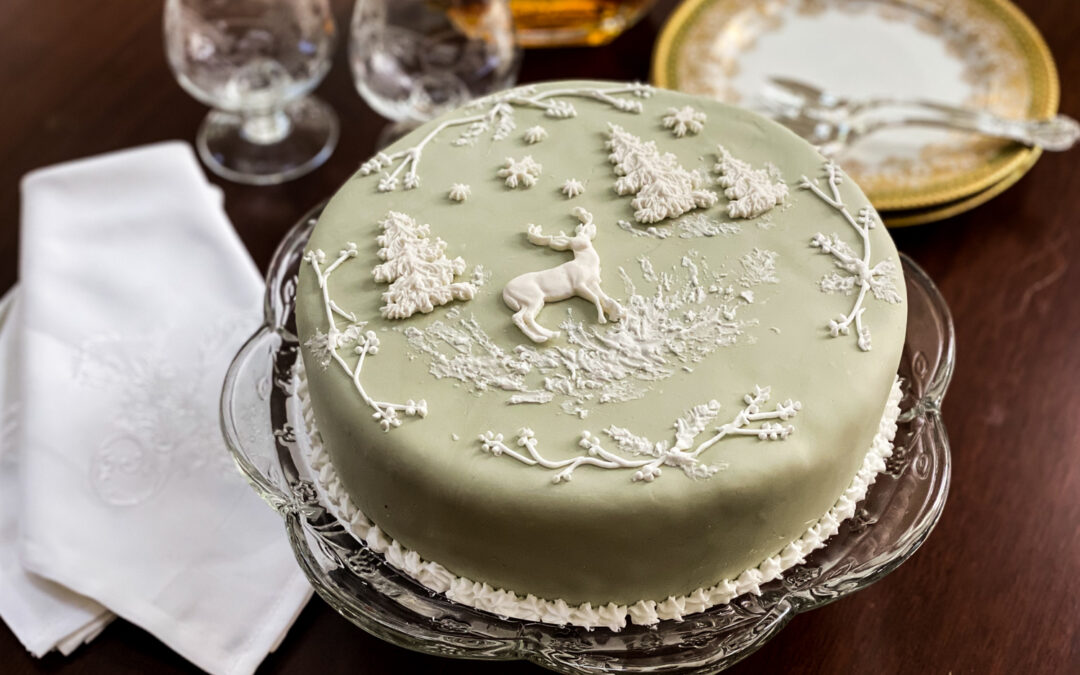
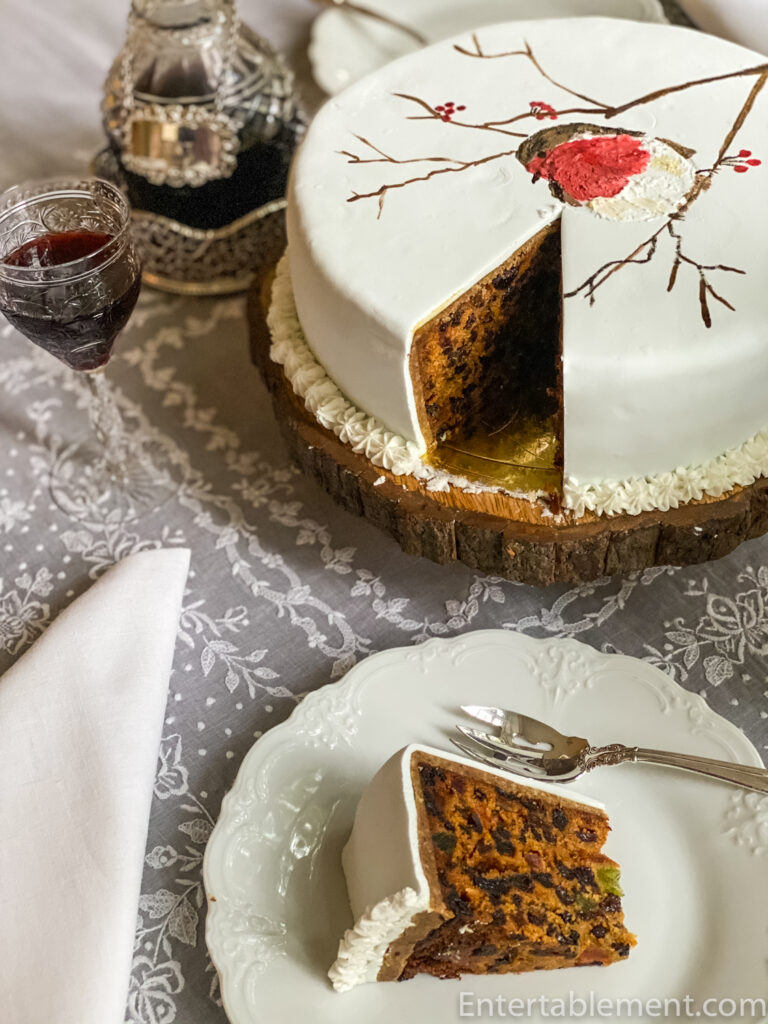

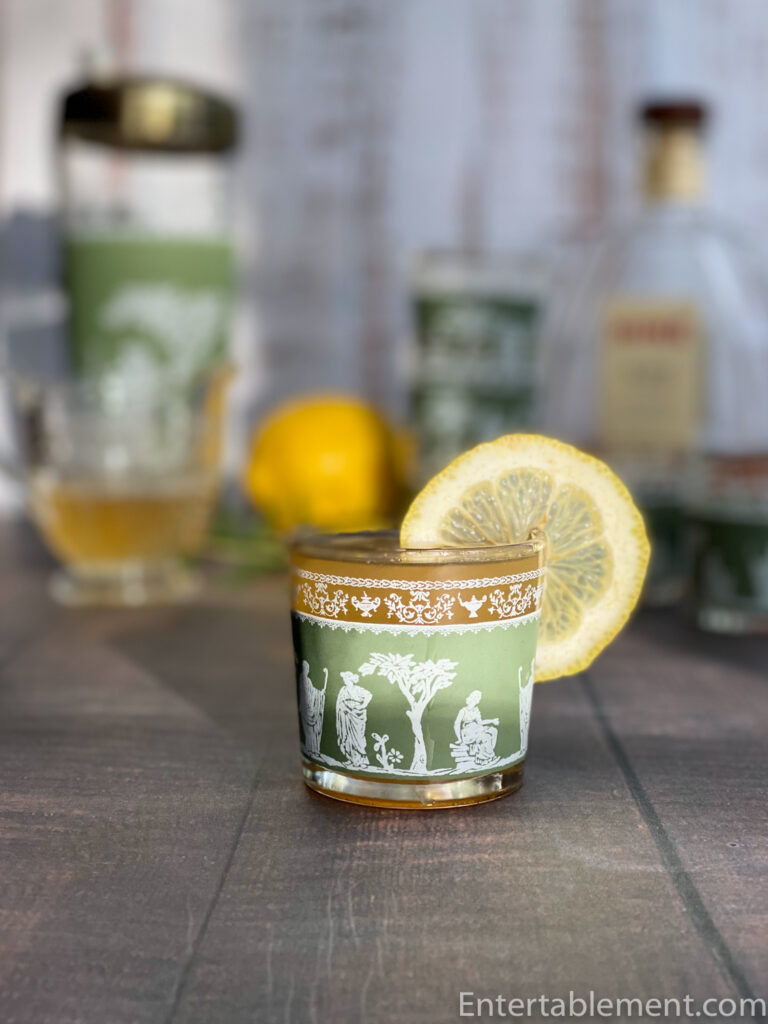
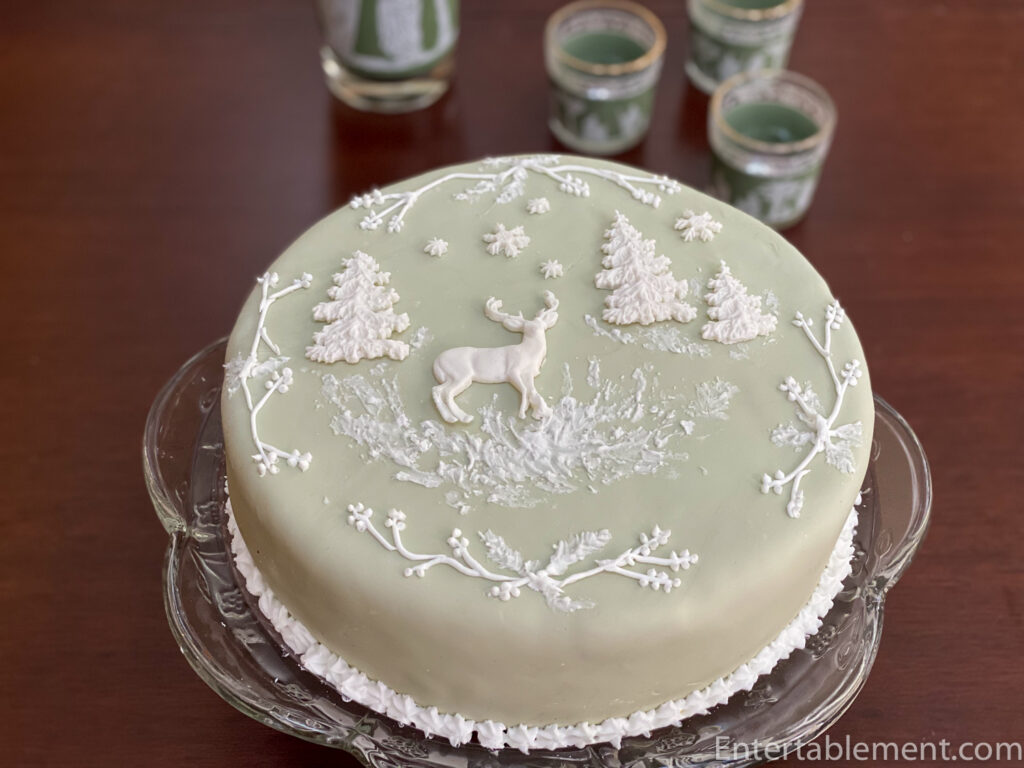
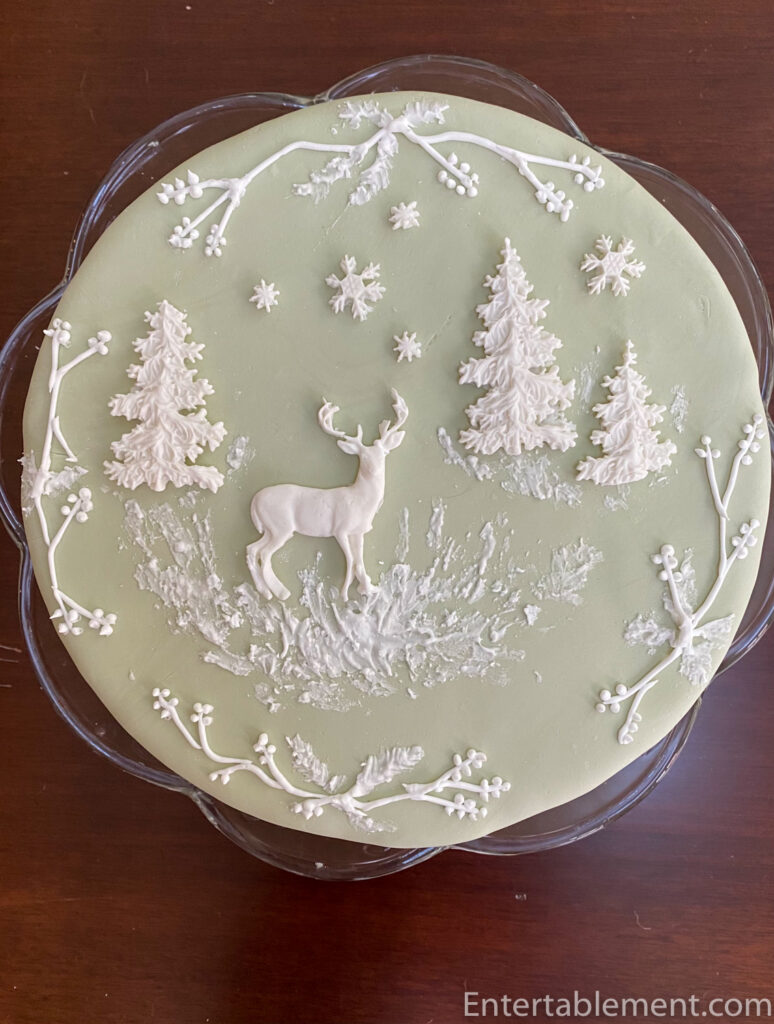

This cake looks too beautiful to cut after many hours (I’m sure) to decorate. We miss these cakes that all our neighbors made in the Uk. We’re now subjected to tasteless copies of dried raisin cake. Keep on baking!
Surprisingly, it didn’t take that long to decorate. Once I got the hang of the moulds, it went really quickly. Rolling out marzipan and fondants was easy, just the piping and painting was a bit finicky.
Next year I’ll be sure to bake one for you and Bill! Great to enjoy with some cheese and a sipping brandy or Scotch.
Happy first day of Advent Calendaring.
Dear Helen, This looks a picture! Too lovely to eat, but too late to start this year to get fully “brandied.” We get very good quality marzipan here, ready-made. But that marshmallow fondant looks really light and worth making at home. Point 3 under the fondant instructions says to place the fondant over the (already) marzipan-covered cake, which must have gotten there the same way the fondant did, yes? Hope the kids enjoy The Snowman.
Oh, well spotted, Beatrice, thank you! I’ve updated the recipe to include the steps on draping the cake with marzipan. You’re an eagle-eyed editor, and I very much appreciate it.
I have a hate-hate affair with marzipan, unfortunately. I got incredibly sick as a child coincident with eating a cake made with almond paste and haven’t been able to abide it since. Plus, the good stuff comes flavoured with rosewater in addition to the almond extract, which doesn’t improve things for my taste buds. It is, however, invaluable in decorating fruit cakes, as the fondant would rapidly become stained from the fruitcake without it acting as a barrier. I made a pecan version for the robin cake, and while it did the job, it wasn’t as tasty as I had hoped. So back to the dreaded marzipan it was!
Beautiful cake!!! Fabulously unique tinted icing! Last time I had homemade fruitcake, my Father’s very formal Mother, Grandma made one in a square slicing “log”. So much fruit & nuts there was 1% cake to hold everything together. Like eating a sweet slice of stained glass.
Your Grandma’s cake doesn’t sound very appetizing.
Fruitcake can be quite a divisive dessert, can’t it?
A time machine bringing Grandma and your recipe together would’ve been lovely. She was ahead of her time as a female college graduate with a degree in Home Economics. Can always spot one of her recipe cards because 1/8 or 1/16 tsp measurements are included.
Sounds like there was nothing slapdash about your Grandma! She’d have loved the new digital scales-incredible precision at a very reasonable cost.
Your Dreamy Wedgewood-Styled Cake is truly a masterpiece of art and love! You are very talented Helen. Thank you for sharing this gorgeous cake and recipe.
You’re very kind, Rachelle. I really enjoy getting absorbed in those projects, and I figure if it doesn’t work out, we can always just eat it. No harm done!